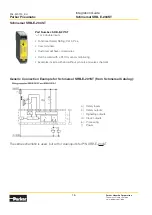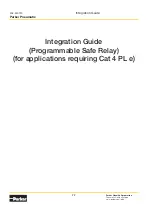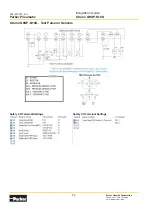
Parker Hannifin Corporation
Pneumatic Division Europe
www.parker.com/pde
11
Integration Guide
P33 Validation
FRL-SIF-120
_EU
Parker Pneumatic
Test Procedure – De-Actuation Fault Monitoring (with Fault Latching)
NOTE: These test procedures required fault simulation. It will be necessary to induce faults electrically by disabling
one solenoid or the other at different times, which may require special test cabling in order to complete the test
procedure.
Also, be aware that this would only be possible with solenoid wiring option A.
See product
data sheet.
1. Energize solenoids A & B, simultaneously. This switches the valve on and should result in air pressure being
supplied downstream from supply port 1 through outlet port 2, and exhaust port 3 being shut off. Sensors A &
B should both switch off.
2. De-energize only solenoid A. The safety control system should detect the fault in the valve where sensor A
switches on and sensor B stays off more than 150 msec after sensor A switches on. This fault should trigger
the safety outputs to switch off in order to de-energize both solenoids A and B. The fault should be latched in
by the safety control system logic until the system is reset. While the fault exists supply port 1 is blocked and
downstream air from outlet port 2 is open to exhaust port 3. Once the safety control system de-energizes the
solenoids sensors A and B should be both on.
3. Before attempting to reset the safety control system, attempt to energize both solenoids A and B
simultaneously. Supply port 1 should remain blocked and downstream air from outlet port 2 should remain open
to exhaust via exhaust port 3.
4. De-energize both solenoids A & B.
5. Reset the safety control system.
6. Energize both solenoids, A & B simultaneously. This switches the valve on and should result in air pressure
being supplied downstream from supply port 1 through outlet port 2, and exhaust port 3 being shut off. Sensors
A & B should be both switched off.
7. De-energize only solenoid B. The safety control system should detect the fault in the valve where sensor B
switches on and sensor A stays off more than 150 msec after sensor B switches on. This fault should trigger
the safety outputs to switch off in order to de-energize both solenoids, A & B. The fault should be latched in
by the safety control system logic until the system is reset. While the fault exists supply port 1 is blocked, and
downstream air from outlet port 2 is open to exhaust port 3. Once the safety control system de-energizes the
solenoids, sensors A and B should both be on.
8. Before attempting to reset the safety control system, attempt to energize solenoids, A & B simultaneously.
Supply port 1 should remain blocked and downstream air from outlet port 2 should remain open to exhaust via
exhaust port 3.
9. De-energize both solenoids A & B.
10. Reset the safety control.
Test Procedure for Loss of Supply Pressure While Actuated
1. Energize both solenoids, A & B, simultaneously. This switches the valve on and should result in air pressure
being supplied downstream from supply port 1 through outlet port 2, and exhaust port 3 being shut off. Sensors
A & B should both switch off.
2. Remove supply air from supply port 1. Sensors A & B should switch on. External monitoring should detect the
fault in the valve where both solenoids are on, but both sensors are also switched on. This fault should trigger
the safety outputs to switch off in order to de-energize both solenoids, A & B. The fault should be latched in
by the safety control system logic until the system is reset. While the fault exists, supply port 1 is blocked, and
downstream air from outlet port 2 is open to exhaust port 3. Sensors A and B should remain on.
3. Re-supply air to supply port 1. Supply port 1 is blocked and downstream air from outlet port 2 is open to
exhaust via port 3. Sensors A & B should both be on. Re-supplying air while the fault is latched in the safety
control system should not result in air being supplied from supply port 1 to outlet port 2.
4. Reset the safety control system.




























